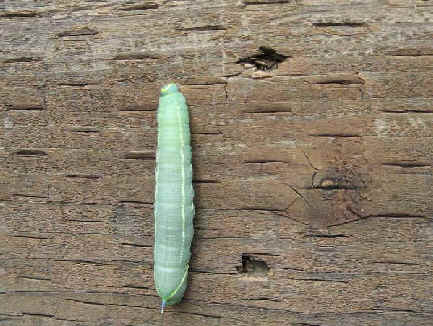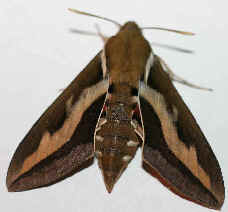 A
List
A
List
of
Butterflies
and
Moths
In
Alaska
with those seen during
Focus On Nature Tours
in Alaska
noted with an (*)
A List of Alaska Butterflies and Moths
compiled by Armas Hill
Upper right photo: OLD WORLD SWALLOWTAILS
Among the Lepidoptera groupings
in this list, Links to:
Swallowtails, Parnassians Whites, Marbles, Sulphurs Coppers, Hairstreaks,
Blues
Brushfoots (including Fritillaries, Tortoiseshells) Satyrs (including Alpines, Arctics)
Skippers Moths
Codes:
Numbers in the list below noted as
(K:xx)
refer to pages in the
Kaufman Focus Guide to Butterflies of North America,
by Jim Brock & Kenn
Kaufman
Numbers in the list below noted as
(PW:xx)
refer to plates in the
Peterson Field Guide to Western Butterflies,
by Paul Opler
&
Amy Barttlett
Wright, 1999
(i/E): introduced from
Eurasia
(AKr): rare in Alaska
(ph): species with a photo in the FONT website
Additional Links:
Upcoming Alaska FONT Tour Itineraries
Birds in Alaska
Mammals in Alaska Wildflowers & Other Plants in Alaska
Other Lists and Photo Galleries of
Butterflies and Moths

Butterflies:
SWALLOWTAILS and PARNASSIANS
- Canadian Tiger Swallowtail ______
(PW:5) (K:21)
Papilio canadensis
(Range: Alaska east to northern New England)
- Old World Swallowtail (*) (ph) ______
(PW:3)
(K:33)
Papilio machaon
Papilio machaon aliaska ______ subspecies in
Alaska and northwest Canada
Papilio machaon
is known for its "hill-topping", a form of
lekking behavior.
In "hill-topping", males may be found flying up to and
staying on a hilltop, for days on end if necessary.
Females, desirous of mating, fly up the hill.
Males dash around the top, competing for the best part of the area - usually
the very top, as the male with the best territory at the top of the hill
would have the best chance of mating with the occasional female, who knows
that the "top male" must be strong and thus genetically fit.
Papilio machaon aliaska nectars
on Labrador Tea.
- Phoebus Parnassian ______ (PW:1)
(K:45)
Parnassius phoebus
Parnassius phoebus apricatus ______
subspecies from southern Alaska to northwestern British Columbia,
Canada
Parnassius phoebus golovinus ______ subspecies on
the Seward Peninsula in Alaska, described in 1930
- Eversmann's Parnassian ______ (PW:1)
(K:45)
Parnassius eversmanni
The Eversmann's Parnassian flies close to the ground over open
tundra. It occurs in Alaska, and in Canada in Yukon, the western Northwest
Territories, and northern British Columbia.
WHITES, MARBLES,
SULPHURS
- Arctic White (*) ______
(PW:8) (K:47)
Pieris angelika
The Parry's Wallflower is a good host plant for Pieris
angelika, a far-northern species of "mustard
white".
- Western White ______ (PW:8)
(K:49)
Pontia occidentalis
- Large Marble ______
(PW:8)
(K:55)
Euchloe ausonides
- Northern Marble (*) ______
(PW:9) (K:55)
Euchloe creusa
The Northern Marble flies in the late spring and early summer,
making it a notably early flier in northern areas.
- Green Marble ______ (PW:9)
Euchloe naina
- Clouded Sulphur ______ (PW:10)
(K:61)
Colias philodice
- Pelidne Sulphur ______ (PW:11)
(K:63)
Colias pelidne
- Christina's Sulphur ______
(PW:10)
(K:63)
Colias christina
- Giant Sulphur
______ (PW:11) (K:65)
Colias gigantea
- Palaeno Sulphur (ph)
______ (PW:11) (K:65)
Colias palaeno
Other names for Colias
palaeno are Arctic Sulphur and Moorland Clouded
Yellow.
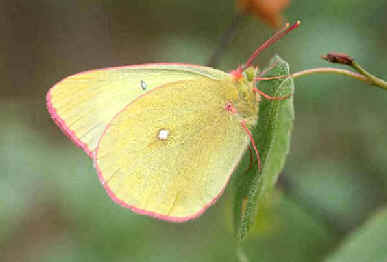
A Palaeno, or Arctic Sulphur
- Labrador Sulphur
______ (PW:11) (K:65)
Colias nastes
- Canadian Sulphur
______ (PW:11) (K:67)
Colias canadensis
Colias canadensis is a recently
distinguished species. It was previously confused with the Hecla Sulphur
(below).
The female of Colias
canadensis shows dimorphism. It is usually white, but
sometimes orange or yellow with the normal black borders.
- Hecla Sulphur
______ (PW:11) (K:67)
Colias hecla
- Booth's Sulphur
______ (PW:11) (K:67)
Colias tyche thula
The Booth's Sulphur is
rarely seen south of the Brooks Range.
COPPERS, HAIRSTREAKS,
BLUES
- American Copper (ph)
______ (PW:14) (K:81)
Lycaena phlaeas
Lycaena
phlaeas is also called the Small Copper.
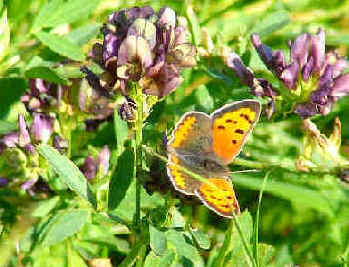
A Small (or American) Copper photographed during a
FONT tour
(photo by James Scheib)
- Dorcas Copper
______ (PW:15) (K:85)
Lycaena dorcas
- Mariposa Copper ______ (PW:15)
(K:89)
Lycaena mariposa
- Hoary Elfin
______ (PW:18) (K:105)
Caliophrys polios
- Western Pine Elfin ______ (PW:18)
(K:107)
Callophrys eryphon
- Western Tailed-Blue (*) ______ (PW:19) (K:125)
Everes amyntula
- Silvery Blue ______
(PW:20) (K:125)
Glaucopsyche lygdamus
- Spring Azure (*) ______ (PW:19)
(K:131)
Celastrina ladon
- Greenish Blue ______
(PW:20) (K:135)
Plebejus saepiolus
- Northern Blue ______ (PW:20)
(K:135)
Lycaeides idas
- Arctic Blue ______ (PW:21)
(K:137)
Agriades glandon
- Cranberry Blue
______ (PW:21) (K:137)
Vacciniina optilete
BRUSHFOOTS
- Mormon Fritillary ______
(PW:24) (K:161)
Speyeria mormonia
Northern bogs hold several species of
lesser fritillaries in the genus BOLORIA (below), many of
which were named for Norse goddesses.
- Frigga Fritillary ______
(PW:25)
(K:169)
Boloria frigga
- Silver-bordered Fritillary ______
(PW:25) (K:171)
Boloria selene
- Bog Fritillary (ph)
______ (PW:25) (K:171)
Boloria eunomia

Bog Fritillary
- Polaris Fritillary
______ (PW:25) (K:171)
Boloria polaris
The Polaris Fritillary occurs in
open tundra areas. It flies mid-summer, 1 brood.
- Astarte Fritillary
______ (PW:25) (K:171)
Boloria astarte
The Astarte Fritillary lives on
rocky tundra ridges.
- Mountain
Fritillary ______ (PW:25) (K:173)
Bolaria napaea
- Dingy Fritillary
______ (PW:25) (K:173)
Boloria improba
- Freija Fritillary
______ (PW:25) (K:175)
Boloria freija
Boloria freija
has a distinctive pearl spearpoint
underneath.
- Purplish
Fritillary ______ (K:175)
Boloria montinus
- Arctic Fritillary (*)
______ (PW:25) (K:175)
Boloria chariclea
- Cryptic Fritillary
______ (PW:25) (K:175)
Boloria natazhati
Boloria natazhati is also called
the Beringian Fritillary.
- Northern Crescent ______ (PW:28)
(K:177)
Phyciodes selenis
- Field Crescent ______
(PW:28)
(K:179)
Phyciodes campestris
- Variable Checkerspot ______ (PW:28)
(K:193)
Euphydryas chalcedona
- Green Comma ______ (PW:29)
(K:199)
Polygonia faunus
Polygonia faunus
is also known as the Faun Anglewing.
- Hoary Comma ______ (PW:29)
(K:199)
Polygonia gracilis
- Compton Tortoiseshell ______
(PW:29)
(K:201)
Nymphalis vaualbum
- Milbert's Tortoiseshell (ph) ______
(PW:29) (K:201)
Nymphalis milberti
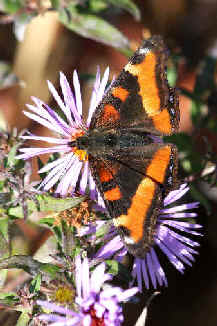
Milbert's Tortoiseshell
(photo by Doris Potter)
- Mourning Cloak (*) (ph) ______ (PW:29)
(K:203)
Nymphalis antiopa
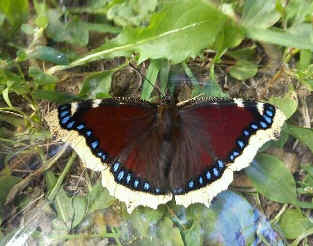
Mourning Cloak
- Painted Lady (ph) ______
(PW:29)
(K:205)
Vanessa cardui

Painted Lady
(photo by Doris Potter)


 A
List
A
List 







